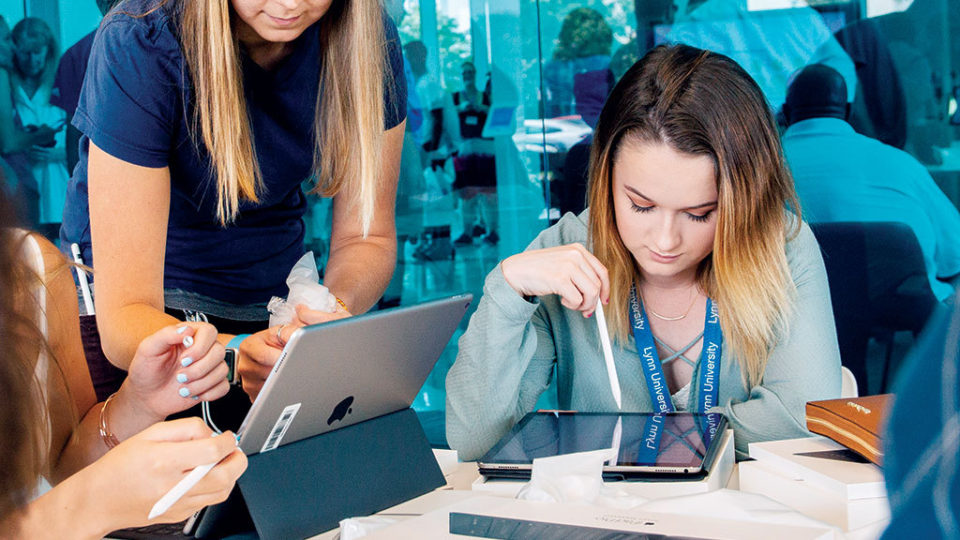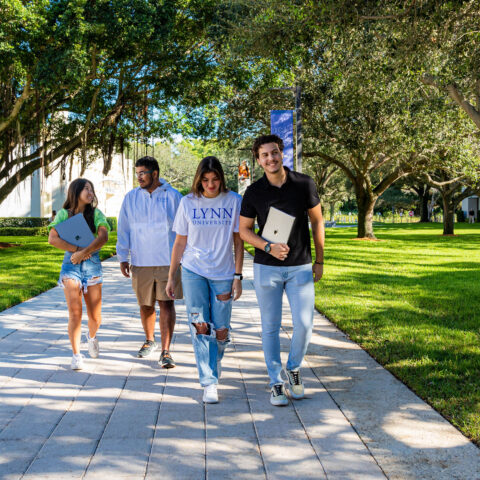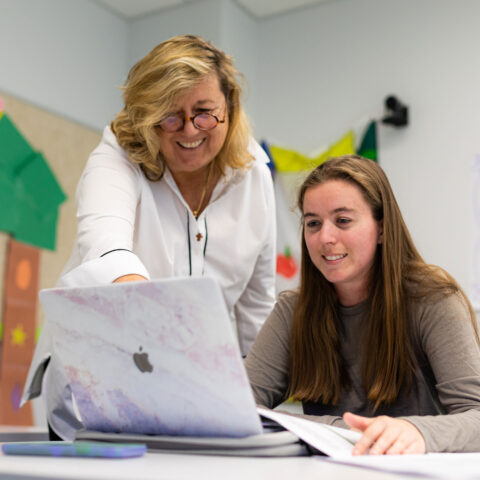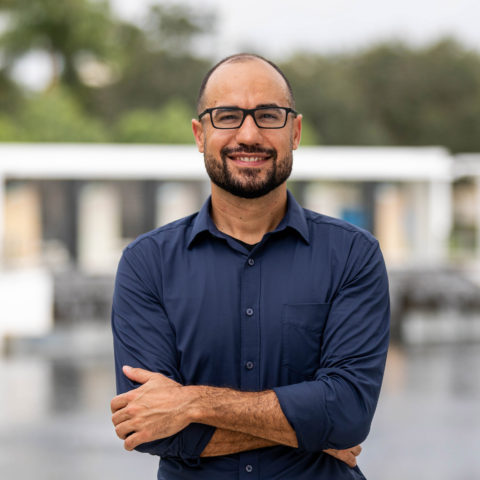Last January, Lynn took its award-winning iPad-powered learning to a new level, with the iPad Pro. Now, students and faculty can’t imagine learning without it.
In 2013, Lynn University turned heads when it launched iPad-powered learning. After an initial rollout of iPad minis to faculty and undergraduate students, a few months later, the devices were in every student’s hands. Faculty uploaded courses to iTunes U and created free, interactive textbooks through the Lynn University Digital Press. Students experienced engaging content that perfectly delivered Lynn’s discussion-driven Dialogues core curriculum. They also saved up to 90 percent in textbook costs.
The world took notice. Apple twice named Lynn an Apple Distinguished School and recognized Mike Petroski, who spearheaded faculty development, as an Apple Distinguished Educator. A slew of publications, including Inside Higher Ed and The Chronicle of Higher Education, highlighted Lynn’s pioneering work. U.S. News & World Report named Lynn one of America’s Most Innovative Colleges.
But most important—and the sole reason behind the initiative—is the transformation in students’ learning: 90 percent of Lynn students report the iPad contributes to their learning experience.
Why tinker with that kind of success? Because, as faculty will tell you, that’s the Lynn way—continually stretching the limits of learning.
Teaching tomorrow’s teachers
Just in time for Spring 2016, Lynn deployed iPad Pros and Smart Keyboards and Apple Pencils to faculty and undergraduate students. The larger, more robust device and custom accessories provide a tool not just for content consumption, but also creation. Susan Saint John, assistant professor of education, recalled, the iPad Pro “took off like a rocket.”
Saint John, a former Palm Beach County Schools principal and current Lynn Ed.D. student, uses the iPad Pro extensively in teaching her Introduction to Education, Child Development and Classroom Management courses. But it was as a student in a Lynn doctoral class that she discovered Kahoot!, a lesson review app. Users create a learning game using multiple choice questions, which participants answer using their cellphones. Saint John tried the app in her undergraduate classes, and it was a hit.
Sophomore Taylor Collins is a fan of the app. “Kahoot! was fun, and a good way for us to study,” she said. “I use the iPad Pro every day. I also take notes and make presentations in Keynote and PowerPoint. It helps in communicating with other students.”
In Saint John’s Classroom Management course, the iPad Pro is a great tool for creating class projects that will become part of students’ professional portfolios. “One of their assignments is to create an entire package for their classroom,” Saint John said. “Later when they’re interviewing for jobs, they can say, ‘This is my classroom layout, classroom management plan, open letter to parents and school supply list.’ The whole package will be in one place—on the iPad Pro.”
Sophomore education major Natalie Lusniak likes how the iPad supports different styles of learning. “With the iPad, you can use speech to text. For me, listening to text is much better than reading it.” Lusniak also used the iPad in a Children’s Literature class to create a book for first graders—yet another portfolio piece.

Delving into the Dialogues
Preparing students for the real world is also top-of-mind for Dr. Sanne Unger, who teaches Dialogues courses in the College of Arts and Sciences. In her Dialogues of Belief and Reason class, students master research methods while exploring topics in deviant behavior. They also gain technological skills, such as using Slack, a real-time messaging app favored by Silicon Valley and corporations. “Students have team threads where they can talk to each other, and I can monitor those communications and send messages to them,” she said.
Unger also finds that virtual reality apps engage students, thanks to the iPad Pro’s larger screen. “You can transport yourself to a totally different place,” she said. A favorite app is NYT VR (Virtual Reality Stories from the NYTimes). “Students can see the world through the eyes of others. It’s very impactful.”
Bonnie Bonincontri, an assistant professor in the College of Arts and Sciences, uses short videos in her Dialogues of Justice and Civic Life classes with similar effect. For instance, students see how a woman provides water to a Navajo tribe in Arizona. “We talk about how we take access to water for granted,” Bonincontri said. “Then, I break the class into small groups and ask them, ‘If money were no object, what solutions could you offer?’ They open up their iPads, prepare their presentations and then share them with the class.”
Unger and Bonincontri’s colleague Ronald Weissman teaches Dialogues of Quantitative Reasoning, which focuses on statistics. Because students perform their calculations using Excel, Weissman created a workbook for the iPad Pro. “It features 26 videos where they can see step by step how to do these calculations.”
Weissman is the author of two other digital texts and a seasoned business executive who emphasizes real-world relevance in his teaching. “Most students hate the subject of statistics, so in my course, Predicting the Future, I try to show them how to apply statistics in practical ways and their future careers.”
Hands-on learning
Sports management students are putting their iPad Pros to work in the field. In a Special Topics class taught by Dr. Chad Barr ’02, associate professor of sports management in the College of Business and Management, students worked to expand a soccer tournament, The Palm Beach Cup, in Palm Beach Gardens. Students used their iPads to design social media campaigns, develop sponsorship proposals, conduct weekly meetings via Skype or FaceTime, and create custom maps. “We used Google Maps to look at the surrounding facilities for this tournament,” Barr said. “We used screenshots of maps and other apps to place overlays to create our own maps—everything from identifying power sources to locations for handicapped parking.”
Some professors see the iPad Pro becoming a laptop replacement. “One student’s laptop was broken,” Barr said, “and he did everything on the iPad.” Barr surveyed students for feedback and received positive comments about the iPad Pro, among them:
- “It made creating all the ads 100 times easier using the Pencil and large screen.”
- “Using the split screen helped me visualize everything better.”
- “I did my whole final from my iPad.”
- “It’s extremely convenient; I didn’t have to carry my laptop everywhere.”
A professor’s best friend
Faculty have found new ways to use the iPad—from writing and editing to other day-to-day tasks. Unger has written and edited three digital textbooks at Lynn. “Previewing the books is much easier with the bigger screen,” she said, “and I can work with the embedded videos within the pages, instead of opening them full screen.”
Dr. Rachel Pauletti, assistant professor of psychology in the College of Arts and Sciences, previously taught at a large state university. “Before, I wasn’t expected to learn students’ names because of the large class sizes. At Lynn, where learning is more personalized, that’s not the case. On the first day of class, I walk around the room and record students saying their names and one thing about themselves. I’ll watch that video about 10 times before the next class so that I know everyone’s name on the second day of class.”
Blending new- and old-school methods, Pauletti uses her iPad to grade students’ papers digitally and write notes in the margins. “I like to give a lot of feedback, so having the ability to handwrite comments is great."
Leading innovation
Lynn faculty are proud to be at the forefront of integrating technology into the classroom with iPads. “It’s an absolute necessity,” said Dr. Erika Grodzki, professor of advertising and public relations in the College of International Communication and a Fulbright scholar. “Technology has changed the game. Professors have to keep up with technology, and students do as well. … I attend three to four conferences per year, and I meet professors from all over the world. When I tell them about what we are doing at Lynn, they are amazed.”
Barr shares Grodzki’s enthusiasm. “The iPad is giving students a powerful tool to learn, and our goal is to teach them how to learn. We have every answer right here at our fingertips. … Now it’s unacceptable to say, ‘I don’t know.’ Now, the answer is, ‘Let me find out.’”

Professors tell their stories on Facebook
Lynn faculty members shared on Facebook how they use the iPad Pro. Turning the tables, their students “graded” them, with comments. The professor garnering the most comments was Susan Saint John, and her reward was an Apple Watch.
Saint John is thrilled with her prize—and the iPad as a teaching tool. “There’s so much more I have to learn,” she said, “but even now, I can’t imagine teaching without it.”
Here’s what faculty members had to say about using the iPad Pro
“Students in the MKT 465 course use the Flipboard app on their iPad Pros as a way to highlight the ever-changing world of fashion and retail. Because Flipboard acts as a virtual magazine, students are able to include their own exposé on their final project retail company. It keeps our students engaged in the classroom and creates a hands-on document that can be used for future reference and possible job consideration.”
—Dr. Andrew Burnstine, associate professor, marketing
“Communication and Emerging Media students gain skills in iPad Pro photo correction. This includes color attributes of hue, saturation and luminance levels. They also learn to create presentations with iMovie, which includes transitions, text, effects, animated GIFs, video clip inserts and opening titles.”
—Denise Belafonte-Young, associate professor, film and television
“I’m starting a new method of instructing biology labs in which students can connect their iPad Pros to various scientific sensors through Bluetooth—they can watch data being generated and graphed in real time. Students can measure virtually anything from sound, light and temperature to their own heartbeat and respiration on their iPads. Students can even collect data from the same sensors simultaneously, working together on a single project.”
—Dr. Gary Villa, professor, biology
“Sound studies create a noise map of the environment surrounding an airport, so the government can adequately compensate nearby residents and businesses for excessive noise. Aviation students use their iPad Pros to create a sound video at a local airport. Then, they edit and combine the clips to develop a sound map of the airport and compare their self-made sound map with the airport’s official versions.”
—Dr. Jeffrey Johnson, dean, School of Aeronautics
“We use the iPad Pro’s unique abilities when we study trademarks to gain a deeper understanding of trademark infringement. The split screen allows us to compare the visuals for possible consumer confusion. We use the Apple Pencil to draw over the logos, identifying areas of possible comparison. Then students take an existing logo and use the Apple Pencil to create their own hypothetical version, which is presented to the class with Apple AirPlay.”
—Dr. Theodore Curtis, associate professor, College of Business and Management




